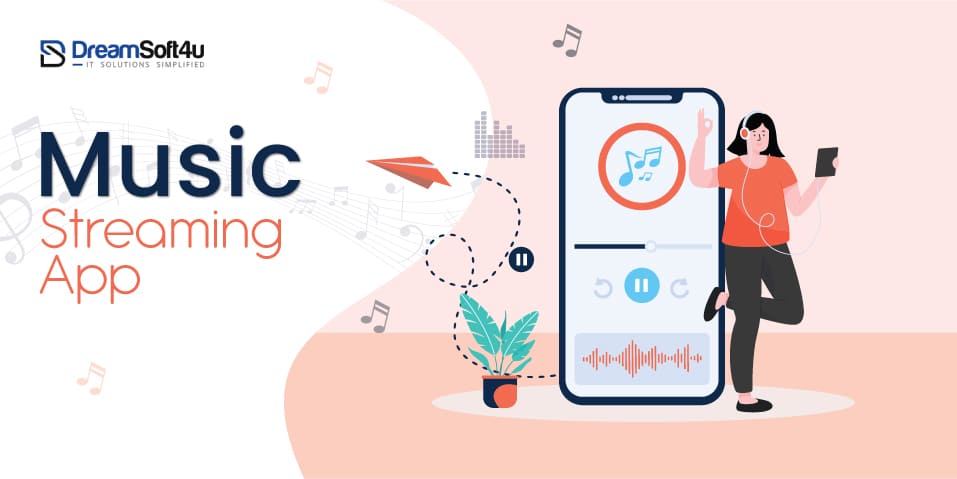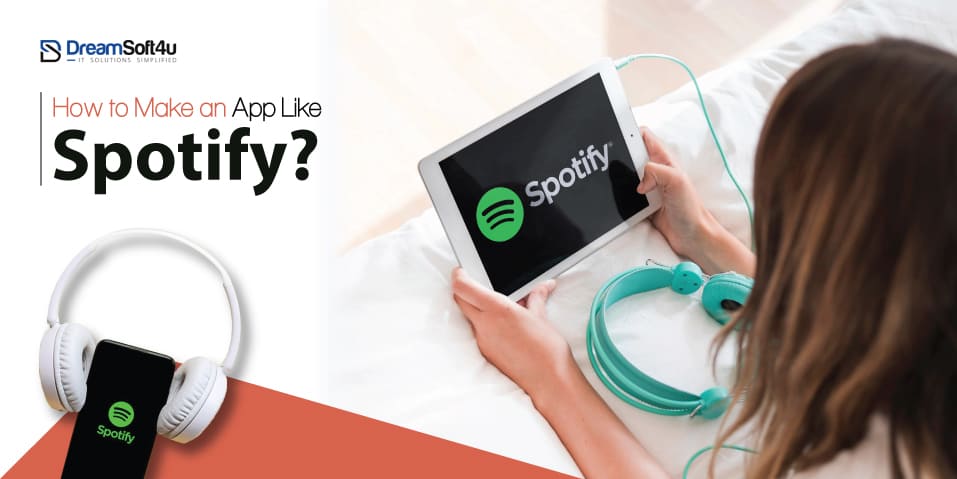The music streaming market is one of the most lucrative markets of today. It is growing fast. No surprise that music streaming app development is becoming a trend.
They are becoming popular and are a great way for music lovers to discover new music. If you are wondering how to make music apps like Spotify? This blog will give you all the information you need about developing an app like Spotify.
We will discuss everything you need to know about music streaming app development. So, let’s get started and revolutionize music streaming in 2023!
Table of Contents
ToggleMusic Streaming Apps: What exactly are they?

Music streaming apps are exactly what the name suggests. They allow users to access a library of songs and albums and stream them online for listening. They can even download songs and listen to them offline.
The music-streaming app market is snowballing. It will reach over $25 billion by 2023. It’s an attractive market for businesses to enter. Hence, the soaring demand for custom app development companies that can build music streaming apps.
You May Also Like:
How to Make Music Apps like Spotify? 5-Step Strategy
Developing a music app is a complex process that requires a lot of time and effort. It involves many stages: research, planning, design, development, testing, and launch.
Step 1: Market Research for Spotify Clone App Development
The first step is understanding the market and the competition. It will help you identify the features and functionalities you need to include in your app.
Step 2: Create a plan for Spotify Clone App Development
The next step is to create a plan to help you stay organized and on track. After that, you must design the app, including creating the user interface and experience.
Step 3: Designing The Spotify Clone App
The first thing to do in this stage is to sketch your idea on paper. It will help you visualize your idea and make it easier to communicate with others.
Next, wireframe your idea. Wireframing is the process of creating a low-fidelity prototype of your app. Once you have a rough idea of what you want your app to look like, you can start wireframing. It will help you figure out the layout and flow of your app.
Once you have your app’s layout and flow, you can create a high-fidelity prototype. An app prototype is a simulation of an app used to test its feasibility and functionality. It will give you a better idea of what the final product will look like.
Step 4: Coding the Spotify clone app and integrating APIs and SDKs.
After the prototype is ready, the first step is to create the backend code. This code will manage the user accounts, song playback, and other backend tasks.
The next step is to create the front-end code. This code will display the user interface and handle user interactions.
The final step is connecting the backend and front-end code so the app can function.
Step 5: Testing the Spotify Clone App
Once the development is complete, you must test it to ensure it works as expected. Testing the app during development is essential to ensure a robust app. It allows you to identify errors and bugs and ensures the app is ready for release.
Let’s Discuss Your Project
Get a free consultation and let us know your project idea to turn it into an excellent digital product
98+ Client Retention
Deployment & Infrastructure
You will need robust deployment and infrastructure components. They will ensure seamless app hosting and maintenance. Let’s look at each in more detail.
- DevOps – It takes care of the deployment process and ensures the infrastructure is hosted correctly.
- CDN – This component is responsible for hosting and delivering the app’s static assets. It’s a robust and reliable network that delivers static assets quickly.
Get a free quote on your music streaming app development. Hire app development services now.
You May Also Like:
Technology Stack for Developing Spotify Music Streaming App
The tech stack behind a Spotify clone app is vast and complicated. But understanding it will help you successfully create a music streaming app.
Below, we’ll share an overview of the music streaming app tech stack.
Front-End Technologies
- For Mobile: The language behind the front-end mobile app is JavaScript and Kotlin.
- For Web: The popular web framework used by Spotify is CEF (Chromium Embedded Framework). It makes creating and maintaining large-scale apps more manageable, especially as the user base grows.
- For Data Query: Spotify’s modern data query language is Cassandra, which allows for flexible data querying for apps. This means you can modify the app to suit the business needs and requirements of the app.
Backend Technologies
The runtime environment and server-side framework used by Spotify is Node.js. Spotify has been using Node.js since its early days. It’s a robust and scalable runtime environment.
Node.js is a perfect fit for Spotify because it’s fast, scalable, and easy to use. Node.js also has a large community of developers familiar with it, making it easy to find help when needed.
Spotify Clone App: Architecture
Now that we’ve explored the various technologies and tools used in the app let’s look at how they’re all put together. The architecture of Spotify’s app is robust and designed for scalability. Let’s look at them in detail.
- Front End: The app’s front end decides the user experience. It includes the user interface, the website, and all the content.
- API: This component allows you to query your data. In other words, it bridges your app data and users.
- Middleware: The middleware component handles user authentication and session management.
- Data Storage: The data storage component hosts the data, whether User or content.
Key Features of Spotify Music Streaming App
Of course, there are some basic features of the Indian music app Gaana or Spotify that you will need to consider. These include
- 👉 User accounts: Users can create their accounts. It will store their personal information, favorite songs, and playlists.
- 👉Music library: It allows users to browse a library of songs and albums and stream them online.
- 👉Search and filter: Users can quickly find the songs they are looking for. They can use keywords or filter the library by genre, artist, or album.
- 👉Playlists: Users can create playlists of their favorite songs. They can even save it, share it, and edit it later.
- 👉Radio: People still love listening to the radio. Adding this feature to your music streaming app will help attract a larger audience.
- 👉Social integration: It allows users to share their favorite songs and playlists on social media platforms.
- 👉Push notifications: Send notifications to users about new songs and albums, upcoming events, and more.
But when developing a music streaming app, it is important to include features that will help it stand out. Some examples of these include
- Offering a wide variety of music genres to choose from
- Providing lyrics for users to follow along with as they listen to their favorite songs
- Allowing users to listen to music offline can be helpful for users who want to listen to music without using up their data plan.
- It would be best to consider integrating music discovery while creating a music app. This feature allows users to discover new music based on their interests and listening habits.
- Additionally, you can offer exclusive content. This can be interviews with musicians or behind-the-scenes footage from recording sessions.
Let’s break down the features category-wise. It will help you prepare an accurate roadmap to develop a Spotify Clone App.
User Panel Features for Music Streaming App
- Log in or sign up with an email or social media account.
- Search music by genre, artist, album, or playlist
- Listen to music offline or online
- Listen to radio streaming
- Create and manage playlists
- Download audio tracks and listen offline
- Like & Share, track and share on social media networks.
- Background music play
- Lockscreen info (artist, track, cover)
- In-app purchases(remove ad)
Admin Panel Features For Music App Owners
- Secure login to the admin dashboard
- Add, delete, and edit artists, albums, songs, and playlists.
- View user statistics, charts, and news
- Manage app settings, subscriptions & memberships
You May Also Like:
Platforms for Developing a Music Streaming App
When developing a music streaming app, choose the right platform. You can choose from two leading platforms: iOS and Android. Both have advantages and disadvantages. So understand their differences before deciding.
- iOS: iOS is the operating system used by Apple devices such as iPhones and iPads. It has a unified development environment and a wide range of tools and libraries. But, it is more expensive to develop an app for iOS.
- Android: Android is the operating system used by most mobile devices. Developing an app for Android is relatively easy. It is also less expensive to develop an app for Android as the development costs are slightly less.
Expert Advice 👉 Go Cross-Platform if you want to save time and money. You can use the same codebase for your Android and iOS apps. Our team of experienced developers can help you with all you need for cross-platform custom app development.
Cost of Music App Development
Want to know the cost of music app development?
The cost of developing a music streaming app depends on several factors. Generally speaking, you can expect to spend anywhere from $50,000 to $200,000 on developing a music streaming app.
Furthermore, we have broken down country-wise Spotify clone app development cost rates!
| Country | Cost/Hour |
| UK | $100-190 |
| USA | $100-150 |
| Australia | $75-$100 |
| India | $25-50 |
| UAE | $25-75 |
- App Development Cost in the USA: The cost of app development in the USA can vary depending on the features and complexity of the app. The basic hourly charge for a Spotify app development MVP will be $100-150.
- App Development Cost in India: The cost of Spotify clone app development in India can vary depending on the hourly rate charged by the developer. Typically, the cost ranges from $25 to $75 per hour.
- App Development Cost in the UK: Hourly rates for Spotify app development costs can vary depending on the developer’s location and experience. In the UK, the average rate is £50-£75 per hour.
- App Development Cost in Australia: Hourly rates for Spotify app development in Australia vary depending on the developer’s experience and skills. Generally, the cost of Spotify app development ranges from AU$50 to AU$ 150 per hour.
- App Development Cost in UAE: Spotify app development cost in UAE may vary depending on various factors. However, the average hourly rate for Spotify app development is $150.
Revenue Model for a Spotify Like Music Streaming App
The most popular revenue model is subscription-based. This model allows users to subscribe to the app for a monthly or yearly fee. This fee can vary depending on the features and functionalities the users have access to. The app can also offer in-app purchases, such as additional features or access to premium content.
Monetization Strategies for Music Streaming Apps
When developing a music streaming app, it is essential to consider how you will monetize it. You can use a few strategies to monetize your app.
- Advertising: It is one of music streaming apps’ most popular monetization strategies. Advertising allows you to generate revenue by displaying ads in the app. It can be a great way to generate a steady stream of income.
- In-app purchases: In-app purchases allow users to purchase additional features or access premium content. It is a tried and tested way to make money from your app.
- Sponsorships: Sponsorships allow you to partner with brands or companies to promote their products or services in the app. It can be a great way to generate revenue without relying on advertising.
Launch Your Own Spotify Clone App
Convert Your Idea into Reality
98+ Client Retention
Different Types of Music Streaming Apps
When developing a music streaming app, you must consider what type of app you want to develop. Two popular options are
- Streaming-only apps: They allow users to stream music online but not download it. They are usually free to use and generate revenue through advertising or in-app purchases.
- Downloadable apps: These apps allow users to stream music online and download it for offline listening. They are usually subscription-based and generate revenue through subscriptions and in-app purchases.
Still confused about the best money making cash app idea? Talk to an expert now!
Tips for Developing an App Like Spotify/Ganaa
When developing an app like Spotify, a few tips can help you ensure your app is successful.
- Focus on user experience: Make sure your app is easy to use and has a great user experience.
- Leverage Social Media: Integrate social media platforms so users can easily share their favorite tracks and playlists with their friends.
- Invest in marketing: You can reach a broad audience and acquire new users.
- Leverage data: Leverage data to understand user behavior and improve the user experience.
- Offer discounts: Offer discounts and promotions to attract new and retain existing users.
Final Words
Developing a music streaming app is a complex process that requires a lot of time and effort. With the proper knowledge and resources, you can revolutionize music streaming in 2023. So, what are you waiting for? Create a music streaming app today with DreamSoft4u by your side.
Whether you need to develop a Spotify clone app or a completely new music streaming app, our experienced developers will do the job for you. We offer a wide range of services, from app development to marketing and branding, so you can be sure your app will succeed. Contact us today for a free consultation!























